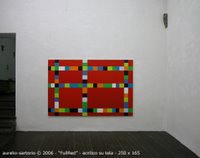Colours for Reflecting on Colour
By Claudio Cerritelli
Aurelio Sartorio’s painting is rigorously structured and yet, at the same time, is receptive to intuitive discoveries that interfere with the constructive principles of colour and go beyond rational methods by the use of unstable, prismatic, destabilizing perceptive tensions.
The theoretical rules of “thinking about painting” never prevail over the flow of experimental balances created during the act of painting. The result of each painting, then, is a continuous verification of the relations between space and colour, between the format of the surface and the intensity of the layers of paint, between the fullness and emptiness of the strokes, as well as the rhythmic shift of intermediate spaces.
With respect to the radical stance of “constructive painting” Sartorio, instead, works with the internal contradictions of the basic rules, he investigates the various moments for stabilising the overall light, and he captures tonal harmony through an arduous procedure, one shot through with hardly visible subtle variations.
The choice of a basic orthogonal grid (his favourite formats are squares and rectangles) leads to a working process that starts from an empirical rule for developing intuitive tensions within this pre-established order. The artist never follows mathematical principles; the image is controlled by asymmetrical balances suspended among multiple chromatic gradations.
In fact Sartorio invents strange colours, gradations of light that change according to the size, “impure colours” that derive from the conjunction of luminous dualities, light that hovers between red and lilac, blue and green, white and pale blue, to give just a few examples. The artist explores the boundaries between entities that change into another chromatic essence, into a new rule resulting from the dialectical action of colour: this is a specific challenge that allows him to capture, without reference points, unusual effects of light, its dissonances and differences, its gleams and luminosity. The fact is that Sartorio prefers a transversal approach, he does not trust conventional colours but prefers instead to play with the visual ambiguity of colours as they oscillate at the edge of vision. It is not by chance that he is attracted by the vein of madness that animates Mannerist painting, one that can give rise to “new colours” through non-naturalistic filters of light.
This is intimate, dramatic, lonely, and placid painting, we read in a note Sartorio wrote about his work: these disquieting definitions of his painting increase its force, reveal a pathos that does not exclude the emotional overtones of the subject.
In the works chosen for this show the colours are strong and contrasted, the structural harmonies change by way of calculated mutations of tone. The fusion of the various parts is always balanced between cold and warm luminous values, the eternal antinomies of light that cannot always be foreseen in the synthesis of the image. Precisely for this reason, Sartorio thinks of painting as a discipline veiled by the secret temptations lying beyond the threshold of the visible; it is an art that does not give way to the lure of geometry, and invents colours for reflecting on colour.
Claudio Cerritelli

No comments:
Post a Comment